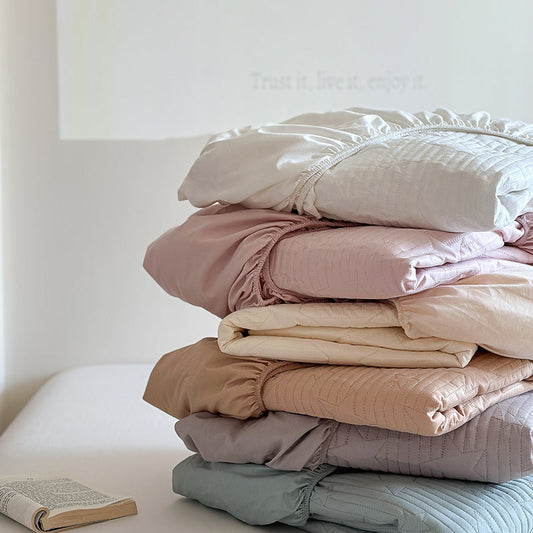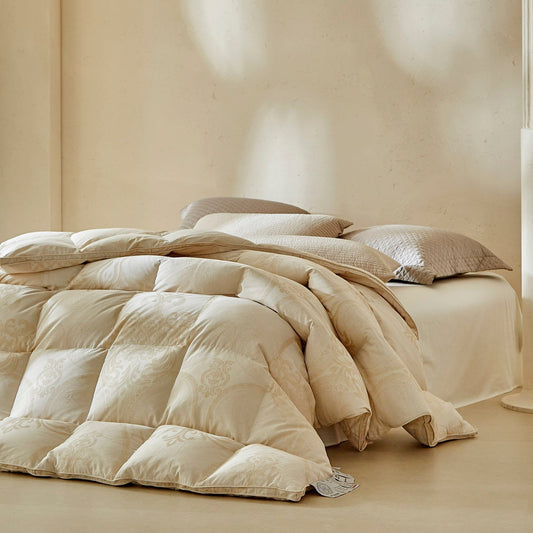When shopping for bed sheets, you'll notice that product labels are packed with technical specs. Even sheets made from the same material can feel completely different to the touch. One key reason for this? The weaving technique.
Want to pick the perfect bedsheet for yourself?
Just learn the basics of these three weaving styles. Read through the explanations below, and you’ll easily figure out which type suits you best!
Percale weave, twill, and satin are three different fabric structures—none is inherently better than the others. Their unique designs simply give each one distinct characteristics.
Percale weave, twill, and satin are the three fundamental fabric weaves in textiles. All other variations—like modified weaves, combined weaves, complex weaves, and jacquard patterns—are built by altering or mixing these three. That’s why they’re called the 'basic weaves' or 'foundation weaves'.
What is Percale weave

Percale weave is the simplest fabric structure, where the warp (vertical) and weft
(horizontal) threads pass over and under each other in an alternating 1×1 pattern.
Percale weave Characteristics

1.Maximum Durability
Why? The warp and weft threads crisscross in a strict 1-over-1-under pattern. This creates:Highest thread interlacing → Extreme strength & abrasion resistance.
Short "floats" (exposed thread segments) → Firm, crisp texture but reduced elasticity and muted sheen.
2.Identical & Smooth on Both Sides
The fabric looks and feels exactly the same on front and back, with a perfectly flat, smooth surface—great for reversible designs or crisp prints.
3.Lightest Weight Option
When comparing fabrics of the same material and thread count, plain weave is consistently the thinnest and most lightweight.
4.Resists Pilling & Fuzz
Tight interlacing prevents loose fibers from tangling, so it stays neat over time (no annoying fuzz balls!).
5.Low-Density & Easy to Unravel
Can’t be woven as tightly as twill/satin (threads naturally space apart), Feels slightly rough to the touch but breathes well.
What is Twill Weave

"Twill weave creates diagonal lines (called 'wales') by having yarns skip over/under multiple threads in a staggered pattern."
Right-Hand vs Left-Hand Twill
↗ Right-Hand Twill: Diagonal lines ascend to the right (common in denim).
↖ Left-Hand Twill: Diagonal lines ascend to the left (softer drape, used in wool suits).
Key Visual Cue
"Flip the fabric—if the diagonals point the same way on both sides, it’s twill!"
Twill Weave Characteristics

Softer & More Drapable Than Plain Weave
Fewer interlacing points create longer "floats" (thread segments on the surface), resulting in:
1. Enhanced softness (ideal for shirts, dresses)
2. Better luster (light reflects smoothly off floats)
3. Higher thread density(more threads per inch without compromising structure)
4.Not as durable as plain weave.
![]() What is Sateen weave
What is Sateen weave

In a satin weave, each warp yarn passes over (or under) four or more weft yarns before interlacing again. These interlacing points are isolated, non-adjacent, and evenly distributed within one repeat unit of the weave pattern.
Warp-faced satin weave
A satin weave where warp floats dominate the fabric face (more warp-over-weft interlacings than weft-over-warp), or where the visible surface primarily shows long warp yarns.
Weft-faced satin weave
A satin weave where weft floats dominate the fabric face (more weft-over-warp interlacings than warp-over-weft), or where the visible surface primarily shows long weft yarns.
Satin Weave Fabric Characteristics

Satin weave fabrics are known for their smooth, glossy surface with a distinct sheen. The front and back sides look different, each dominated by either warp or weft yarns. The long floats (uninterrupted yarns) on the surface reflect light effectively—especially when made from lustrous, low-twist filament yarns—enhancing the fabric’s shine.
Because the interlacing points are spaced far apart and hidden beneath the floats, the fabric’s surface appears seamless, resulting in these key traits:
1.Prone to snagging/pilling:Long floats (warp or weft) are prone to snagging, pilling, and abrasion.
2.High density and softness:With minimal yarn interlacing, satin allows for tighter weaving, making it thicker, softer, and more drapeable than plain or twill weaves.
3.Sleek and shiny:The smooth, even surface maximizes light reflection, giving satin its signature luster.
Now we can easily see the key benefits of plain weave, twill, and sateen bedsheets.
Percale sheets
- Durable & Sturdy:Tight weave creates a strong, long-lasting fabric
- Smooth & Lightweight: Flat surface with identical sides; ideal for breathability in warm climates
- Budget-Friendly: Simpler construction typically means a lower price point
![]() Twill sheets
Twill sheets
-
Softer and more plush
- Thicker and more durable
- Stronger texture and depth
Sateen sheets
Rich color vibrancy—the weave gives them a subtle sheen.
- High thread count, making them smoother and silkier to the touch compared to standard cotton
- Prone to snagging if not handled carefully (e.g., rough washing or long nails)
- More expensive due to the premium weave and materials
Durability:Percale Sheets▶︎Twill sheet▶︎Sateen sheets
Shine/Gloss:Sateen sheets▶︎Twill sheet▶︎Percale Sheets
Softness:Sateen sheets▶︎Twill sheet▶︎Percale Sheets
Density:Sateen sheets▶︎Twill sheet▶︎Percale Sheets
Texture/Feel:Sateen sheets▶︎Twill sheet▶︎Percale Sheets



